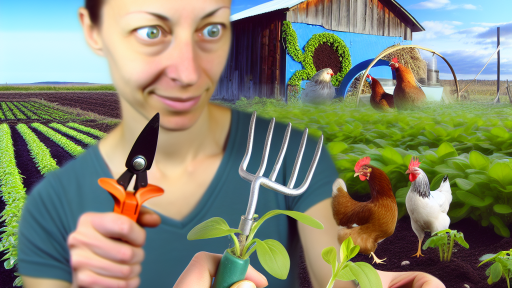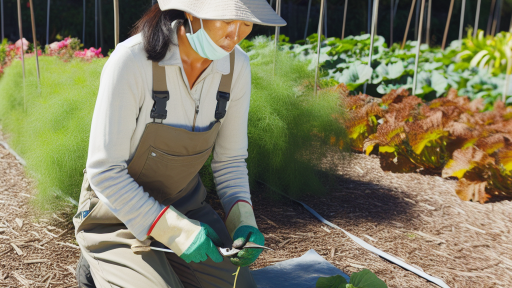Introduction
Small-scale farming plays a vital role in sustainable living.
It allows individuals to grow fresh, healthy produce at home.
A thriving garden offers numerous benefits, including access to organic fruits and vegetables, reduced grocery costs, and the joy of self-sufficiency.
Home-grown food ensures quality and flavor while reducing your carbon footprint.
Whether you have a small backyard or just a few pots on a balcony, small-scale farming can transform your space into a productive oasis.
The benefits extend beyond the table, providing mental and physical health advantages through outdoor activity.
The purpose of this blog post is to offer practical tips for successful small-scale farming.
These tips will help you maximize your garden’s potential, ensuring a bountiful harvest.
From choosing the right crops to optimizing your garden layout, we will cover key strategies that promote growth and sustainability.
By implementing these tips, you can achieve a thriving garden that supports your goals of fresh produce and sustainable living.
Let’s explore how you can turn your small space into a thriving, productive garden that yields satisfying results year after year.
Planning Your Garden Space
When it comes to small-scale farming, planning your garden space is crucial for a thriving garden.
Here are some tips to help you make the most of your space:
Assess available space and sunlight exposure
- Measure the size of your garden area to determine how much space you have to work with.
- Observe how much sunlight your garden receives throughout the day to plan where to place sun-loving plants.
- Take note of any areas that are shaded or receive less sunlight for plants that thrive in shade.
Importance of soil quality and preparation
- Test your soil to determine its pH level and nutrient content for optimal plant growth.
- Amend your soil with organic matter such as compost or aged manure to improve its texture and fertility.
- Consider raised beds or container gardening if your soil is poor quality or contaminated.
Choosing the right plants for your climate and space
- Research plants that are well-suited to your climate and growing conditions for a successful garden.
- Consider the mature size of plants and their space requirements when deciding what to plant.
- Choose a variety of plants to attract beneficial insects, promote biodiversity, and maximize yield.
By carefully planning your garden space, considering sunlight exposure, soil quality, and plant selection, you can create a thriving garden on a small scale.
Soil Management and Preparation
- Healthy soil is crucial for optimal plant growth and overall garden success.
- Conduct a soil test to determine pH levels, nutrient deficiencies, and soil composition.
- Amend soil as needed based on the results of the soil test to create an ideal growing environment.
- Incorporate organic practices to maintain soil fertility and support sustainable gardening methods.
Importance of Healthy Soil for Plant Growth
Healthy soil is the foundation of a thriving garden.
It provides plants with essential nutrients, proper drainage, and a stable root environment.
Soil health directly impacts plant growth, yield, and overall garden productivity.
By prioritizing soil management, you can ensure that your plants have the best possible chance of success.
Techniques for Soil Testing and Amending
Before planting, it’s important to conduct a soil test to assess the current condition of your soil.
This test can provide valuable information about pH levels, nutrient deficiencies, and soil composition.
Once you have the results, you can make informed decisions about how to amend the soil to meet the specific needs of your plants.
Common amendments include compost, organic matter, and minerals like lime or gypsum.
Organic Practices for Maintaining Soil Fertility
Organic gardening practices focus on building and maintaining healthy soil without the use of synthetic chemicals.
By utilizing techniques such as composting, crop rotation, cover cropping, and mulching, you can improve soil fertility, structure, and microbial activity.
These practices enhance nutrient availability, water retention, and overall soil health, promoting long-term sustainability in your garden.
Efficient Watering Techniques
- Use rain barrels to capture and store rainwater for your garden.
- Implement a drip irrigation system to deliver water directly to plant roots.
- Mulch around plants to retain moisture and reduce evaporation from the soil.
- Water in the early morning or late evening to minimize water loss through evaporation.
- Group plants with similar water needs together to optimize watering efficiency.
Methods to conserve water and ensure proper hydration
- Collect rainwater in barrels to use for watering your garden.
- Use a soaker hose or drip irrigation system to target plant roots.
- Water deeply but infrequently to encourage deep root growth.
- Consider installing a rain gauge to track rainfall and reduce unnecessary watering.
- Implement a timer on your irrigation system to avoid overwatering.
Importance of mulching and drip irrigation
- Mulching helps retain soil moisture and reduce the need for frequent watering.
- Drip irrigation delivers water directly to plant roots, minimizing water waste.
- Mulch acts as a barrier to prevent evaporation and maintain soil temperature.
- Drip irrigation systems can be automated for efficient and precise watering.
- Both mulching and drip irrigation promote healthy plant growth and reduce water usage.
Recognizing signs of overwatering and underwatering
- Wilting leaves and yellowing foliage may indicate overwatering.
- Soggy soil, mold growth, and root rot are signs of excessive watering.
- Underwatering can cause wilting, dry soil, and stunted growth in plants.
- Try the finger test by checking soil moisture before watering your garden.
- Observing plant behavior and adjusting watering accordingly is crucial for a thriving garden.
Read: Grow Herbs Indoors: Small Space, Big Yields
Sustainable Pest and Weed Control
When it comes to small-scale farming, sustainable pest and weed control are essential for maintaining a thriving garden.
By implementing organic and natural methods, preventing weed growth, and promoting biodiversity, you can effectively manage pests and weeds without harming the environment.
Organic and Natural Pest Control Methods
- Use companion planting to deter pests
- Introduce beneficial insects like ladybugs
- Utilize homemade insecticidal soaps
- Apply neem oil as a natural pesticide
Organic pest control methods are not only safer for the environment and beneficial insects but also ensure that your produce remains free from harmful chemicals.
By using natural remedies, you can effectively manage pest populations without compromising the health of your garden.
Techniques for Preventing Weed Growth
- Mulch your garden beds to suppress weeds
- Hand-pull weeds regularly to prevent them from spreading
- Practice crop rotation to disrupt weed growth cycles
- Use landscape fabric to inhibit weed germination
Preventing weed growth is crucial in small-scale farming as weeds can compete with your crops for nutrients, water, and sunlight.
By implementing proactive strategies like mulching and hand-weeding, you can keep your garden free from invasive plants and ensure that your crops thrive.
Importance of Biodiversity in Pest Management
- Encourage a diverse range of plant species in your garden
- Attract pollinators like bees and butterflies
- Plant trap crops to lure pests away from your main crops
- Rotate crops to prevent pest infestations
Biodiversity plays a crucial role in pest management by creating a balanced ecosystem where predators can naturally control pest populations.
By fostering a diverse environment, you can reduce the likelihood of outbreaks and minimize the need for chemical interventions in your garden.
In fact, sustainable pest and weed control practices are essential for the success of small-scale farming.
By utilizing organic methods, preventing weed growth, and promoting biodiversity, you can create a healthy and thriving garden that supports both your plants and the environment.
With careful planning and a commitment to sustainable practices, you can enjoy a bountiful harvest while minimizing the impact on the ecosystem.
Transform Your Agribusiness
Unlock your farm's potential with expert advice tailored to your needs. Get actionable steps that drive real results.
Get StartedRead: Rooftop Herb Havens: Cultivating Flavor

Crop Rotation and Companion Planting
When it comes to small-scale farming, crop rotation and companion planting are essential practices that can help you maintain a thriving garden.
By rotating crops and strategically planting companions, you can maximize your garden’s productivity while minimizing the risk of pests and diseases.
Benefits of Rotating Crops
- Managing soil health: Crop rotation helps maintain soil fertility by alternating crops that have different nutrient needs.
- Reducing pests and diseases: Rotating crops can disrupt the life cycle of pests and diseases, reducing their impact on your garden.
- Preventing soil erosion: Different crops have different root structures, which can help prevent soil erosion and improve soil structure.
Companion Planting Principles and Examples
- Planting companions: Certain plants benefit from being grown together, either by repelling pests, attracting beneficial insects, or enhancing flavor.
- Examples: Planting marigolds with tomatoes can help repel nematodes, while growing basil near peppers can improve their flavor and health.
Planning a Crop Rotation Schedule
- Assess your garden: Start by assessing the size of your garden, the type of soil, and the plants you want to grow.
- Divide into zones: Divide your garden into zones based on the plants’ families or their nutrient requirements.
- Rotate crops: Plan a schedule to rotate crops within each zone, ensuring that you are not planting the same family of plants in the same spot every year.
- Consider cover crops: In between plantings, consider planting cover crops like legumes to help fix nitrogen in the soil and improve soil structure.
By implementing crop rotation and companion planting in your small-scale farm, you can create a more sustainable and productive garden.
These practices not only help improve soil health and reduce pests but also promote biodiversity and enhance the overall resilience of your garden.
Read: Herb Growing in Pots: The Compact Garden Guide
Harvesting and Storing Your Produce
Indicators for knowing when to harvest different types of crops
- Check the color – ripe fruits and vegetables often have vibrant colors.
- Feel the texture – fruits should be firm but slightly give when squeezed.
- Smell the produce – a sweet or fragrant aroma indicates ripeness.
- Look for signs of maturity – vegetables should be at their full size.
Best practices for harvesting to ensure plant longevity
- Use sharp tools to prevent damaging the plant.
- Harvest in the morning when the plant is fully hydrated.
- Handle produce gently to avoid bruising or compromising quality.
- Cut stems at an angle to promote regrowth and prevent waterlogging.
- Remove any damaged or diseased parts to prevent spread.
Techniques for storing and preserving your produce
- Store fruits and vegetables in a cool, dry place away from sunlight.
- Utilize airtight containers or bags for leafy greens and herbs.
- Freeze or can excess produce for long-term preservation.
- Consider pickling or fermenting vegetables for added flavor and preservation.
- Rotate older produce to the front of the fridge to use first.
Read: Tiny Space, Huge Taste: Easy-to-Grow Herbs
The Role of Composting
Composting plays a vital role in small-scale farming as it benefits soil health and reduces waste.
In this section, we will explore the importance of composting, how to start and maintain a compost system, and how to effectively use compost in your garden.
Benefits of Composting
- Composting enriches the soil by adding essential nutrients, such as nitrogen, phosphorus, and potassium.
- It improves soil structure, making it easier for plants to access nutrients and water.
- Compost helps retain moisture in the soil, reducing the need for frequent watering.
- Composting reduces the need for chemical fertilizers, leading to healthier plants and soil.
- It helps reduce waste by diverting kitchen scraps and yard waste from landfills.
How to Start and Maintain a Compost System
- Choose a suitable location for your compost bin or pile, ideally in a sunny spot with good drainage.
- Layer green materials (such as fruit and vegetable scraps) and brown materials (like leaves and straw) in equal parts.
- Keep your compost moist but not waterlogged, turning it regularly to aerate the pile and speed up decomposition.
- Avoid adding meat, dairy, or oily foods to your compost, as they can attract pests and slow down the process.
- Monitor the temperature of your compost pile – it should heat up as decomposition occurs, killing off weed seeds and pathogens.
Using Compost Effectively in the Garden
- Use mature compost as a soil amendment, mixing it into your garden beds before planting to improve soil fertility.
- Top-dress your garden with compost in the spring to provide a nutrient boost for growing plants.
- Make compost tea by steeping compost in water to create a liquid fertilizer for your plants.
- Use compost as mulch around plants to suppress weeds, retain soil moisture, and regulate soil temperature.
By incorporating composting into your small-scale farming practices, you can improve the health of your soil, reduce waste, and create a sustainable garden environment.
Start composting today and reap the benefits of this natural and effective soil amendment!
Continuous Learning and Experimentation
- Staying informed with new farming techniques is crucial for small-scale farmers.
- Attending workshops, seminars, and conferences can provide valuable insights into innovative practices.
- Subscribing to agricultural magazines and online newsletters can keep you updated on the latest trends.
Resources for Further Learning
- Websites such as Sustainable Agriculture Research and Education (SARE) offer free publications and resources.
- Books like “The Market Gardener” by Jean-Martin Fortier provide in-depth guidance on successful farming methods.
- Local workshops and extension programs hosted by universities or agricultural organizations can offer hands-on training.
Encouragement to Experiment and Document Garden Progress
- Experimenting with different crops, planting techniques, and soil amendments can lead to valuable discoveries.
- Keep a gardening journal to document your observations, successes, and failures for future reference.
- By actively experimenting and documenting your garden progress, you can continually improve your farming practices.
Conclusion
Small-scale farming can be a rewarding and fulfilling experience when approached with the right knowledge and techniques.
By implementing the tips discussed in this blog post, you can create a thriving garden that produces bountiful yields and is sustainable in the long run.
We have highlighted the importance of soil health, crop rotation, companion planting, water management, and pest control.
These are key factors in ensuring your garden’s success and productivity.
It’s essential to always prioritize the health of your plants and soil for optimal growth.
We encourage you to apply these tips in your own gardening practices and observe the positive results.
Remember that every garden is unique, so don’t be afraid to experiment and adapt these tips to suit your specific needs and conditions.
Lastly, we invite you to share your own small-scale farming tips and experiences with us.
We believe in the power of community and knowledge-sharing, so feel free to leave a comment or reach out to us with your insights and success stories.
Together, we can cultivate thriving gardens and sustainable farming practices for a greener and healthier future.




